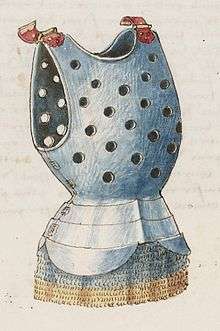Greave
-transparent.png)
A greave (from the Old French greve "shin, shin armour" from the Arabic jaurab, meaning stocking[1]) is a piece of armour that protects the leg.
Description
The primary purpose of greaves is to protect the tibia from attack. The tibia is a bone very close to the skin, and is therefore extremely vulnerable to just about any kind of attack. Furthermore, a successful attack on the shin results in that leg being rendered useless, greatly hampering one's ability to maneuver in any way.[2] Greaves were used to counteract this. Greaves usually consisted of a metal exterior with an inner padding of felt. The felt padding was particularly important because, without it, any blow would transfer directly from the metal plating to the shin.
History
Ancient Greece and Rome
During Greek antiquity, greaves were mentioned in many texts, including Hesiod’s Shield of Heracles, Homer’s Iliad and Virgil’s Aeneid. In the Illiad, the Greek forces are commonly referred to as "well-greaved Acheans" (euknēmidas Achaious). While these are primarily mythological texts, they still dealt with warfare and the fact that greaves were mentioned is evidence that they were indeed in use. There are also non-fictional testimonies of their use among Roman light infantry (or hastati) from Polybius up to Vegetius. These greaves are thought to have been mass-produced by the Romans using presses on sheets of metal and then attaching lining, usually leather or cloth. While it is generally assumed that greaves were always worn in pairs, there is evidence that many wore just a single greave on the left or right leg. Many skeletons have been found buried with only a single greave, including gladiators and soldiers.[3] People may have worn a single greave as a sign of status, as opposed to any practical use.[citation needed]
Medieval Europe
Greaves were common until around the ninth century, when they largely disappeared.[4] The first evidence of their use is in the 1230s or 1250s, most notably the depiction of Goliath in the Trinity College Apocalypse.[5] The lack of other evidence suggests that they were uncommon at the time.[6] Almost all greaves used at this time are known as schynbalds, or greaves that only protected the shin.[6] Illustrations showing “closed greaves”, or greaves that protected the entire leg first appear around 1290 and become popular in the 1320s.[6] Closed greaves are made of two plates joined on the outside by hinges and fastening with buckles and straps on the inside.
Feudal Japan
Japanese greaves, known as suneate, were first introduced during the eleventh century, during the late Heian period.[7] The earliest suneate consisted of three plates of metal covering the shin.[8] By the Kamakura period (1186–1333), suneate became a standard part of Japanese armor. Around the Muromachi period (1334–1572), suneate eventually became a splint mounted on a piece of fabric with mail in between the metal splint and fabric, not unlike European greaves. This is the most common form of suneate, termed shino-suneate, and saw continued use throughout the Momoyama period (1573–1602). Sometimes, cavalrymen used the older three-plate greaves, known as tsutsu-suneate. Like their European counterparts, most suneate contain leather padding on the interior to reduce the impact of blows and to reduce chafing.
Gallery
 Left greave of a Greek Hoplite. This example has elaborate decoration in repoussé (a technique in which metal is impressed from the rear to form a raised design), including a lion's face over the knee and lines emphasizing the calf muscles. Tiny holes lining the top and bottom edges secured a fabric lining and leather straps.
Left greave of a Greek Hoplite. This example has elaborate decoration in repoussé (a technique in which metal is impressed from the rear to form a raised design), including a lion's face over the knee and lines emphasizing the calf muscles. Tiny holes lining the top and bottom edges secured a fabric lining and leather straps.- Thracian greave found in Romania
- Thracian greave found in Romania
- Japanese samurai greaves, or suneate. The knee area has hexagonal iron plates called kikko sewn inside the cloth.
See also
Citations
- ↑ "Greave definition". Yourdictionary.com. Retrieved 2009-04-25.
- ↑ Kaminski, J.; Sim, D. (2012). Roman Imperial Armour: The Production of Early Imperial Military Armour. Llandysul, Wales: Gomer Press. pp. 141–145.
- ↑ Fortenberry, Diane (Oct 1991). "Single Greaves in the Late Helladic Period". American Journal of Archaeology. 95 (4): 623–627. doi:10.2307/505895.
- ↑ Oakeshott, R. (1960). The Archaeology of Weapons. New York: Frederick A. Praeger. pp. 284–285.
- ↑ Oakeshott 1996, p. 284.
- 1 2 3 Oakeshott 1996, p. 285.
- ↑ Robinson, B. (1950). Arms And Armour of Old Japan. London: HMSO. p. 11.
- ↑ Robinson, H. Russell (1969). Japanese Arms and Armour. London: Arms & Armour Press. p. 15.
References
- Oakeshott, R. Ewart (1996) [1960]. The Archaeology of Weapons: Arms and Armour from Prehistory to the Age of Chivalry. Mineola, New York: Dover Publications. ISBN 978-0486292885.
External links

